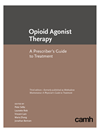Text adapted in 2023 from "Opioid Use and Opioid Use Disorders" in The Primary Care Addiction Toolkit. Available online only.
Prescribing slow-release oral morphine (SROM)
Slow-release oral morphine (SROM) to treat opioid use disorder is considered off-label use in Canada. It is considered a third-line option after buprenorphine and methadone. Physicians who would like to prescribe SROM should meet requirements of the federal section 56(1) class exemption from the Controlled Drugs and Substances Act (Health Canada, 2021). They should also consult a specialist who has experience with this treatment because it requires diligent measures to avoid overdose and diversion.
There are few published clinical guidelines on prescribing SROM to treat opioid use disorder, and recommendations are based mostly on expert opinion (British Columbia Centre on Substance Use, 2017).
How SROM works
SROM is a full agonist opioid with a slow-release (24-hour) oral formulation that can be prescribed as opioid agonist therapy for patients who do not respond adequately to buprenorphine or methadone.
Morphine does not prolong the QT interval, which gives SROM a safety advantage over methadone for patients with cardiac conditions or on medication that prolongs the QT interval.
SROM is prescribed as a witnessed once-daily dose with instructions to the pharmacist to open the capsule and sprinkle the pellets into a medicine cup or onto soft food (e.g., apple sauce, yogurt) for witnessed ingestion. Crushing, chewing or dissolving the pellets can cause rapid release of a fatal dose of morphine. The average total daily dose is 200–1,200 mg.
For patients who use fentanyl, SROM may be co-prescribed with methadone and then either maintained or tapered down once the patient reaches an adequate dose of methadone (Bromley et al., 2021). SROM should be dispensed as daily observed dosing along with methadone.
Candidates for SROM
Clinical guidelines indicate that SROM may be appropriate in particular situations (Canadian Research Initiative in Substance Misuse, 2018; Centre for Addiction and Mental Health, 2021). It can be considered for patients who have severe opioid use disorder and who:
- have not responded to buprenorphine or methadone, have contraindications to these medications or have refused them
- have high opioid tolerance due to fentanyl use disorder.
SROM should be avoided in people who are pregnant or breastfeeding unless other OAT options are not effective or available.


